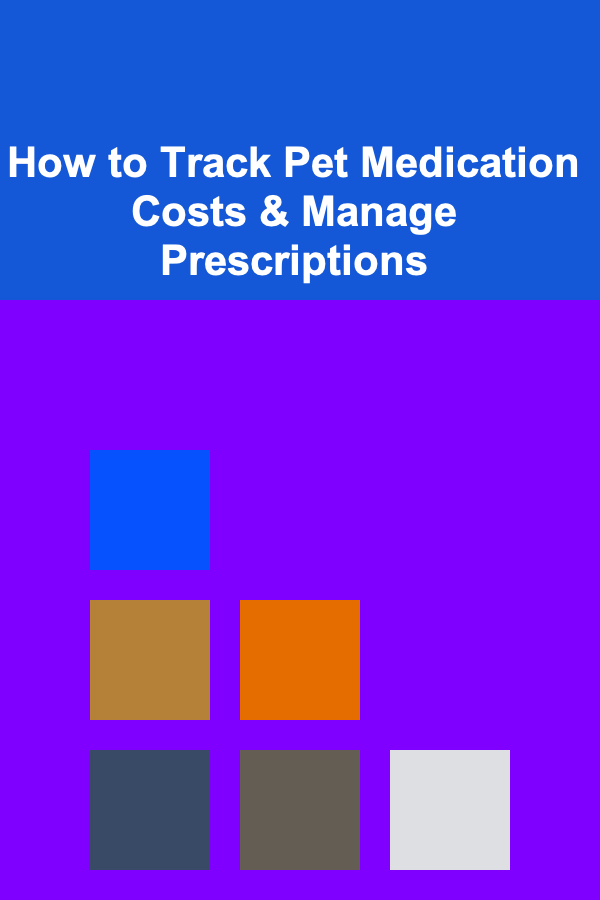
How to Track Pet Medication Costs & Manage Prescriptions
ebook include PDF & Audio bundle (Micro Guide)
$12.99$11.99
Limited Time Offer! Order within the next:

When it comes to caring for our pets, one of the most important aspects is ensuring they receive the proper medication when needed. From regular health maintenance medications to prescriptions for specific conditions, managing pet medications can quickly become a complex and costly endeavor. Understanding how to track medication costs and manage prescriptions effectively can make a significant difference in both the health of your pet and your financial well-being.
This article will guide you through various strategies for tracking pet medication costs, managing prescriptions, and finding ways to save on the often-high price of veterinary care. By utilizing these tips and tools, you can stay organized, keep your pet healthy, and avoid unnecessary expenses.
Understand Your Pet's Medical Needs
Before diving into medication management, it's essential to understand your pet's medical needs. Pets, like humans, may require different types of medications depending on their age, breed, and health conditions. Common pet medications include:
- Flea and tick prevention: Regular treatments are necessary to protect pets from parasites.
- Pain management: For pets recovering from surgery or dealing with chronic conditions like arthritis.
- Antibiotics: Used for treating infections caused by bacteria.
- Chronic condition management: Such as diabetes, thyroid conditions, or heart disease, requiring ongoing medication.
- Vaccinations: While not considered a "medication," keeping up with vaccinations is crucial for your pet's health and longevity.
Understanding your pet's specific needs will help you keep track of the right prescriptions, prevent medication errors, and avoid purchasing unnecessary drugs.
Create a Medication Calendar
A medication calendar is one of the simplest and most effective ways to track when your pet needs their medication and when prescriptions are due for renewal. Here are the key components of an effective medication calendar:
- Dosage Schedule: Record when each medication is given, including the correct dosage and time of day. For pets on multiple medications, this will help prevent accidental double dosing or missed doses.
- Refill Reminders: Set reminders for when prescriptions need to be refilled. Vet prescriptions typically last for a certain period, so knowing when the next refill is due can help avoid interruptions in your pet's treatment.
- Veterinary Appointments: Mark upcoming veterinary appointments on your calendar, so you are prepared to discuss your pet's medication needs with the vet.
- Notes Section: Include any changes in your pet's behavior, reactions to medication, or any side effects noticed. This can be useful when discussing your pet's health with the vet.
A medication calendar can be created in several ways:
- Paper Calendar or Planner: This is a simple and effective method for those who prefer something tangible.
- Digital Calendar or App: Use your smartphone or computer to set recurring reminders for medications and appointments. Many pet-specific apps also allow you to store medication history and manage appointments in one place.
A medication calendar will keep you organized and ensure that you never miss a dose or forget a refill.
Track Medication Costs
Medication costs can vary widely depending on your pet's condition, the type of medication required, and where you purchase the medications. To effectively track these costs, you can:
a) Keep Detailed Records
Tracking costs starts with maintaining detailed records of each medication your pet requires, the dosage, and the price. You can record the following:
- Name of Medication: Write down the name of the medication prescribed.
- Cost per Dose: Track the cost of each dose and the frequency with which it is administered.
- Prescription Refills: Track the cost of each refill. Medications for chronic conditions may need to be refilled regularly.
- Discounts or Coupons: Some pet pharmacies or online retailers offer discounts or coupons for certain medications. Make a note of any deals that apply to your pet's medications.
b) Use a Spreadsheet or Financial App
A spreadsheet is an excellent way to keep track of medication costs over time. You can set up columns for the medication name, cost per dose, quantity, and refill dates, and track the total cost for each period (weekly, monthly, etc.). This will give you a clear picture of how much you are spending on your pet's healthcare.
Alternatively, some pet-specific apps also allow you to input medication costs, track purchases, and even link to your vet's pharmacy for easy reordering.
c) Compare Prices
Medication prices can vary depending on where you purchase them. It's worth checking different sources to find the most cost-effective options. Common places to buy pet medications include:
- Veterinary Clinics: Some vets may offer competitive pricing on medications, especially if they are dispensing the medication directly.
- Online Pharmacies: Websites like Chewy, Petco, and 1-800-PetMeds often offer lower prices for prescription and over-the-counter medications, and they frequently run sales or offer discount codes.
- Local Pet Stores: Some local pet stores also sell flea, tick, and heartworm prevention medications at competitive prices.
- Generic Medications: Ask your veterinarian about generic alternatives. Generic medications can be significantly cheaper and just as effective as brand-name drugs.
Comparing prices will help you find the best deals and prevent overspending on medications.
Consider Pet Insurance
Pet insurance can significantly reduce the financial burden of pet medications, especially for pets with chronic conditions or frequent medical needs. Some policies offer coverage for medication costs, either fully or partially. Here are some points to consider:
- Policy Details: Review your pet insurance policy carefully to understand whether medication costs are covered. Some policies only cover a portion of the medication, while others may cover it fully.
- Reimbursement Process: Many pet insurance companies require you to pay for the medication upfront and then submit a claim for reimbursement. Keep receipts for every medication purchase for this purpose.
- Chronic Condition Coverage: If your pet has a chronic condition, such as diabetes or heart disease, it may be worth investing in a policy that covers the long-term costs of medications.
While pet insurance won't eliminate medication costs entirely, it can help reduce the overall expense of managing long-term health conditions.
Ask for Prescription Flexibility
Veterinarians are often willing to work with pet owners on medication management, especially when it comes to cost. Here are some ways you can work with your vet to lower costs:
- Bulk Prescriptions: Ask your veterinarian if you can purchase a larger supply of medication at once. Buying in bulk may lower the price per dose, especially for long-term medications.
- Alternative Medications: If your pet's current medication is too expensive, ask the vet if there are any alternative medications that are just as effective but less costly.
- Prescription Transfers: Some veterinarians will allow you to transfer prescriptions to a different pharmacy, particularly if you can find a better price elsewhere. Check with your vet to see if they will authorize this.
Don't hesitate to discuss your budget concerns with your vet. They may be able to offer more affordable alternatives or work with you to find a solution that fits your financial situation.
Utilize Discount Programs
Many pet pharmacies, both online and brick-and-mortar, offer discount programs or loyalty rewards for repeat customers. These programs can help reduce the overall cost of pet medications. Look for the following:
- Online Pharmacies: Websites like Chewy, Petco, and Amazon often offer discounts for first-time customers or recurring shipments.
- Pharmacy Loyalty Programs: Some physical pharmacies may offer a loyalty program that provides discounts on prescription refills.
- Manufacturer Coupons: Some pharmaceutical companies provide coupons or rebates for specific medications. Check the manufacturer's website for savings opportunities.
Discount programs can make a significant difference in managing your pet's medication costs, so be sure to take advantage of them.
Consider Generic Options
As mentioned earlier, generic medications are often much cheaper than brand-name drugs but can be just as effective. Ask your vet if there are generic options available for your pet's prescriptions. Common medications with generic versions include:
- Flea and tick preventatives: Generic versions of popular treatments like Frontline and Advantage are available at a lower price point.
- Pain relief medications: Non-steroidal anti-inflammatory drugs (NSAIDs) for pets, such as Rimadyl, often have generic counterparts.
- Heartworm prevention: Generic heartworm preventatives are available and can be a more affordable option.
While generic medications can save you money, always consult your vet to ensure the generic medication is suitable for your pet's condition.
Regularly Monitor Your Pet's Health
Preventative care is often the best way to minimize medication costs in the long run. Regular check-ups and preventive treatments can help identify health issues early, before they require costly medications. Regularly monitor your pet's:
- Weight: Maintaining a healthy weight can prevent many conditions, including diabetes and joint problems.
- Activity Level: Regular exercise helps keep your pet in good health and prevents obesity, which can lead to other health issues.
- Diet: A balanced diet tailored to your pet's specific needs can prevent many health problems.
The less your pet needs medications for chronic conditions, the lower your overall costs will be.
Conclusion
Managing pet medication costs requires organization, research, and proactive care. By tracking medication schedules, comparing prices, exploring insurance options, and working with your veterinarian, you can provide your pet with the necessary care without breaking the bank. The key is staying informed, organized, and prepared for your pet's medical needs. Whether you're managing ongoing prescriptions or occasional treatments, these strategies will help ensure your pet remains happy and healthy, without putting too much strain on your finances.
Reading More From Our Other Websites
- [Home Lighting 101] How to Use Lighting to Define Different Zones in Open Concept Spaces
- [Horseback Riding Tip 101] Pre-Ride Checklist: Preparing Yourself and Your Horse for a Safe Ride
- [Home Renovating 101] How to Approach Home Renovations and Remodeling for Maximum Value
- [Screen Printing Tip 101] Troubleshooting Common Screen Printing Mistakes on Shirts
- [Biking 101] Bike Computers 101: Understanding the Basics and Advanced Features
- [Home Family Activity 101] How to Set Up a DIY Family Indoor Camping Experience
- [Home Renovating 101] How to Add a Touch of Luxury to Your Renovation on a Budget
- [Home Cleaning 101] How to Properly Clean and Store Your Seasonal Decor
- [Home Cleaning 101] How to Clean a Bathroom: Tips for Tackling Tubs, Toilets, and More
- [Home Family Activity 101] How to Build a Family Lego Village for Creativity and Bonding

How to Build a Checklist for Social Media Crisis Management
Read More
How to Organize Your Home Bar for Stylish Entertaining
Read More
How To Program Robots for Dynamic Environments
Read More
How to Master Variable Player Powers in Board Games
Read More
How to Cook with Less Oil and Fat
Read More
How to Create the Perfect Sauna Ambiance: Lighting, Music, and Scents
Read MoreOther Products

How to Build a Checklist for Social Media Crisis Management
Read More
How to Organize Your Home Bar for Stylish Entertaining
Read More
How To Program Robots for Dynamic Environments
Read More
How to Master Variable Player Powers in Board Games
Read More
How to Cook with Less Oil and Fat
Read More